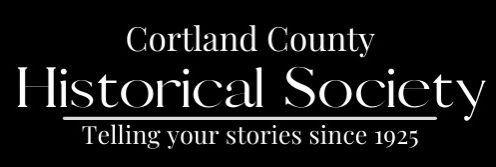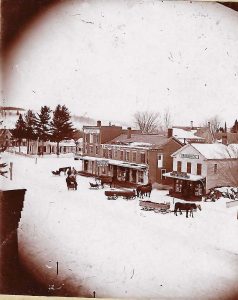The beginning of the history of #3-5 Main Street overlaps with that of #1 covered several weeks ago (https://tinyurl.com/zd4y4h). Joshua Ballard is quoted in H.P. Smith’s “History of Cortland County” as saying: “The corner lot where stands the noble brick edifice of Major Aaron Sager and the Dexter House, was once occupied by a tavern building of ordinary size, owned by Grove Gillett, with whom Samuel Nelson, afterwards one of the judges of the Supreme Court of the United States, took board for a time.” This seems to be a reference to an earlier building, perhaps latter replaced by the Barnard block seen in the earliest available photo of the spot in our collections.
Later, Smith writes that “L. Dexter had a billiard saloon in an old two story wood building adjoining the Barnard block, in the second story of which was Henry Woodruff’s tailor shop.” It is possible that this building was in fact the same as Grove Gillet’s tavern. An advertisement for Lucian Dexter’s saloon indicates that they had a “fresh supply of oysters and clams…received daily by express. Also sardines, lobsters, pickled clams, tongues and feet.” It appears he took pride in the unique selection of delicacies made available at his establishment, which in its early days bore the name First National Restaurant and Saloon and is later referred to as the National Hotel.
In 1872, Aaron Sager and Lucian Dexter rebuilt the entire corner making it a uniform three-story building. A Cortland Standard article from that time reported that the new building would be
“an ornament to the street, and Mr. Dexter deserves credit for his enterprise. When reopened it will be second to no hotel in this section of the State,” (C.S. August 6, 1872). Credit of the building of the new structure was given to William Alvord who was present at the grand opening of the Dexter House in December of that year. “The tables were loaded with the choicest of viands, and the table linen and cutlery spotless in purity and burnish, and the guests did ample justice to the generous repast. After eating was no longer attractive, there was an active demand for speeches, but the responses seemed to be lacking,” the excuse for which was presented by Dr. Jewett “that it was well established by medical science that after such an indulgence of the stomach, it and the brain did not work in harmony,” (C.S. December 24, 1872).
By 1880, the hotel underwent changes to open the ground floor for stores, which early on included the business of C. Van Alstine, a shoemaker. When Lucian moved away from the area, the Dexter House had several different proprietors over the years that included C.H. Warren, C.A. O’Brien and J.J. Comerford, as well as F.E. Mabie and son. It continued to be viewed as a first-class establishment. The Dexter House disappears from city directories by 1926 and was at the time replaced by The Market Basket and Sugar Bowl confectionary. Surprisingly, the Dexter House reappears in 1930 and then was gone for good by 1934.
In 1936, the building was remodeled with a new four-story façade, and remodeled again by A. Louis in 1949. Rear additions were added in the 1960s. By the 1950s much of the building was rented out as apartments and many students resided there. Other businesses that appear in the block over the years included Diamond Taxi, Charles Hairdresser, and various dentists, physicians, and chiropractors.
A fire in 1978 removed the third and fourth floors that contained mainly apartments and destroyed the interiors of A. Louis Men’s Store and George Bowker’s shoe store. By this point in time the building was referred to as the R.H.B. and A.T.&T. building. The fate of the structure seemed doomed for demolition, but as of today if you look down the alleyway to the right of the building you can still view some of the original brickwork of the old Dexter House building.
~Sophie, Collections and Research Assistant




